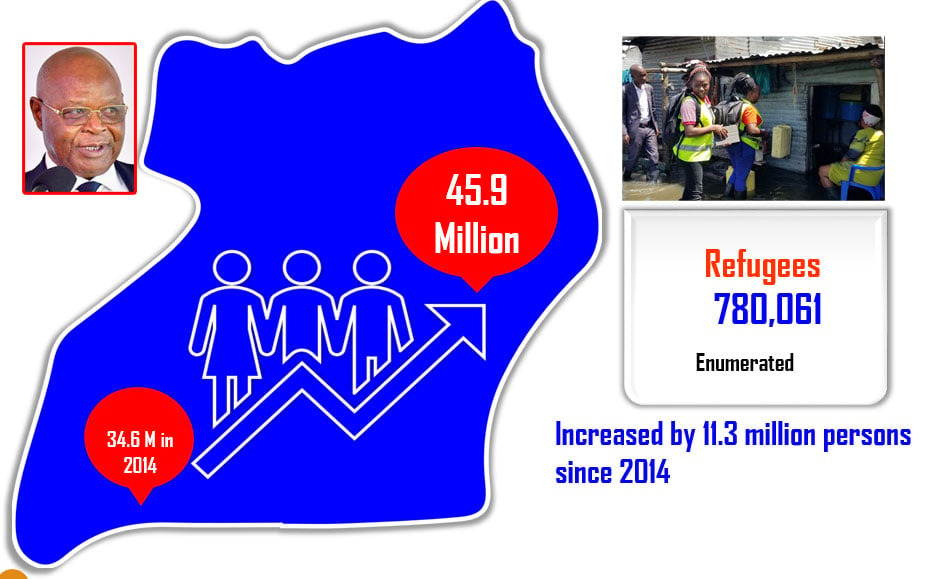
President Museveni waves at Uganda Bureau of Statistics officials after the release of 2024 national census results on June 27, 2024. PHOTO/DAVID LUBOWA
Preliminary results from the 2024 census, released on June 27 by the Uganda Bureau of Statistics (Ubos) show that Uganda has more women than men.
Not since the 10-yearly snapshot offered by the 1969 census have males outnumbered their female counterparts. In the aforesaid census, the first to be held during the postcolonial period, males (4.8 million) marginally eclipsed females (4.7 million).
Save for when parity was registered in 1948 (2.5 million apiece) and 1959 (3.2 million apiece), females have numerically topped once-a-decade surveys staged in 1911 (1.3 million against 1.1 million), 1921 (1.5 million against 1.3 million), 1931 (1.8 million against 1.7 million), 1980 (6.4 million against 6.3 million), 1991 (8.5 million against 8.2 million), 2002 (12.4 million against 11.8 million), and 2014 (17.6 million against 17.1 million).
A key finding from the latest decennial census—having sleepwalked its way past the finishing line in May—is that females (23.4 million) now outnumber their male counterparts (22.5 million) by nearly one million. Never has the difference between the two sexes been that profound. While a 51 percent share of the population does not quite show that Uganda is the very embodiment of a female-dominated society, the statistic is telling regardless.
This is all the more true when the findings of the Uganda Demographic and Health Survey (UDHS) 2022 are reduced to their component parts. The survey stops short of saying that women in Uganda continue to navigate a healthcare system largely built for men.
There is, for one, a noticeable disparity in excess weight gain, with overweight females aged 15 to 49 (18 percent) nearly doubling males aged 15 to 54 (9.2 percent). The gender disparities in obesity are even more vexing, with females (8.4 percent) more adversely affected than males (1.5 percent).
Against the odds?
Empirical evidence adduced by the UDHS 2022 illuminates the sociocultural dynamics that yield such poor outcomes for women. Males that have received education at secondary school level (29 percent against 25 percent) or more (12 percent against eight percent) put their female counterparts in the shade. The fact that men are on the whole better read means they are more likely to make healthier choices such as exercising more.
“Acculturation, through complex sociocultural pathways, affects weight gain among both men and women,” researchers from the Johns Hopkins Bloomberg School of Public Health wrote in a 2012 peer-reviewed paper, adding, “The nutrition transition taking place in many developing countries has also affected excess weight gain among both genders, but has had an even greater impact on the physical activity levels of women.”
Yet that even though females, particularly those in Uganda, drink/smoke less and visit a health facility either earlier or more frequently than males means that their statistical advantage will take some beating. The UDHS 2022, for instance indicates that 24 percent of women aged between 15 and 19 are either mothers or pregnant with their first child. This typically is a poor health outcome, yet there is a silver lining to be found on the proverbial dark cloud.
Expectant mothers, who go for antenatal check-ups have a better chance of growing into the habit of seeking professional interventions, a medical doctor, who asked not to be named, told Saturday Monitor. With the UDHS 2022 putting sterile women in Uganda at just three percent, this means the probability of the country’s female population having a conversation with medical personnel at some point in time is pretty high.
Conversely, men the world over, the doctor added, have gained notoriety for avoiding medical check-ups like a plague. They are also mostly likely to be caught in the crosshairs of suicides and accidents.
All this translates into women typically living longer than men. Consequently, the United Nations’ World Population Prospects (2022) put the life expectancy of women in Uganda at 64.9 years against 60.4 years for men.
The 4.5 years sex gap in life expectancy substantiates what 115,846 enumerators, who either knocked on doors or flagged down the country’s floating population from May 9 to 26, discovered.
Globally, women live on average about five percent longer than men. However, a recent study by scientists at Osaka University found that blocking the production of cells that develop into sperm and eggs in killifish resulted in males living longer and females dying younger than usual. The study could yet prove instructive not least because the ageing process in killifish is not too dissimilar from that in humans.
A fertile nation
In Uganda, the UDHS 2022 showed that thanks to their unfailing eggs, Ugandan women on average have 5.2 children. Going by the findings of the Japanese researchers, such fertility to a certain extent solves the enduring mystery of why Ugandan women outlive Ugandan men.
After all, as the scientists from Osaka University write in Science Advances, germ cell removal (read eggs) leads to “accelerated ageing” in females who, shorn of the antioxidant properties of oestrogen, predispose themselves to cardiovascular disease.
Despite the well-documented fertility of Ugandan women, the census 2024 preliminary results show that the average household size, which previously held steady at 4.7 from 2002, has dropped to 4.4.
The population growth rate has also marginally fallen to 2.9 percent (between 2014 and 2024) from 3.0 percent (between 2002 and 2014), much to the dismay of President Museveni who said on Thursday that he had expected the new population figures to at least threaten the 50 million mark.
The population pyramid sketched by the census 2024 data shows that the most numerically inferior age group is between 75 and 79. Those aged 80 and above outnumber them. The 80-plus age group also marginally outnumbers populations aged between 70 and 74 as well as the subset aged between 65 and 69. Unsurprisingly, females aged 80 and above nearly double their male peers.
Yet the broad base of the pyramid shows in the starkest way possible that the country’s replacement fertility level is high. Children aged 17 and below constitute 50.5 percent of the country’s population. The youth (18 to 30 years) number north of 22 percent.
The over-60s make up just five percent of what, by all measures, is a young country. While the working population (14 to 64 years) musters a beefy 55.6 percent share of the population, it remains to be seen if enough job opportunities can be created for them. Despite economists describing the recent trend of “jobless growth” as a masterpiece of absurd menace, Mr Museveni on Thursday expressed optimism that Ugandans “are [now] joining the money economy.”
Statistics
According to the 2024 census by the Uganda Bureau of Statistics, females outnumber males with a notable margin, comprising 23.4 million compared to 22.5 million males. Females have consistently outnumbered males since 1969. Moreover, women in Uganda exhibit a longer life expectancy than men, with figures from the United Nations’ World Population Prospects (2022) indicating 64.9 years for women versus 60.4 years for men.




